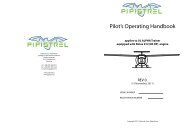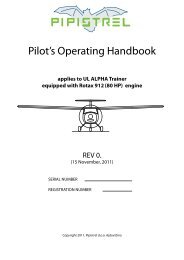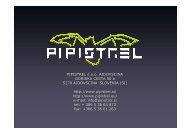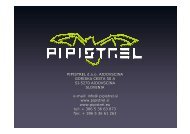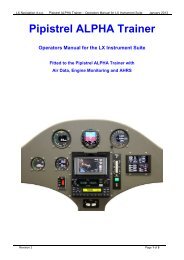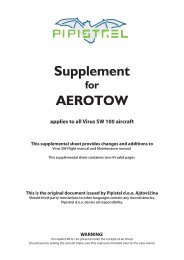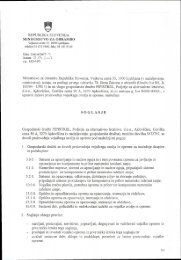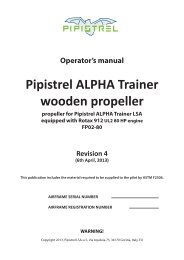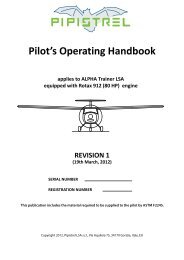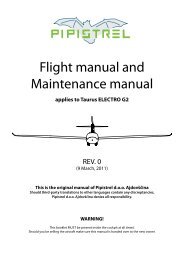ALPHA Trainer Manual Final.pdf - Pipistrel
ALPHA Trainer Manual Final.pdf - Pipistrel
ALPHA Trainer Manual Final.pdf - Pipistrel
Create successful ePaper yourself
Turn your PDF publications into a flip-book with our unique Google optimized e-Paper software.
8-2 <strong>ALPHA</strong> <strong>Trainer</strong><br />
REV. 0 Handling and maintenance<br />
Special inspections<br />
www.pipistrel-usa.com<br />
After having exceeded VNE or landed in a rough manner:<br />
Check the undercarriage, fuselage & wing surfaces and main spars for abnormalities. It is highly<br />
recommended to have the aircraft verified for airworthiness by authorised service personnel.<br />
Clicking noise overhead<br />
The wings are factory fitted to the fuselage to make a tight fit at approximately 80 F. When exposed<br />
to low temperatures, materials shrink. Therefore, flying in the winter or in cold temperatures, you<br />
may encounter “click-clack” like noises above your head. The remedy for this unpleasant noises is to<br />
add washers, tipically of 0,5 mm thickness in-between wing and fuselage. Washers must be added<br />
both at rear and front bushings at one side of the fuselage only!<br />
WARNING! It is mandatory to consult the manufacturer or authorised service personnel<br />
before applying washers!<br />
Draining and refuelling<br />
Whenever draining or refuelling make sure master switch is set to OFF.<br />
Draining the fuel system<br />
The gascolator is located beneath the bottom engine cover on the left hand side of the fuselage.<br />
To drain the fuel system, open the drain valve on the gascolator. Drain approximately 1/2 cup of fuel.<br />
Try to prevent ground pollution by collecting the fuel with a canister.<br />
To close the valve simply turn it in the opposite direction. Do not use force or special tools!<br />
CAUTION! Always drain the fuel system before you have moved the aircraft from a standstill to<br />
prevent mixing of the fuel and eventual water or particles.<br />
Refuelling<br />
CAUTION! Before refuelling it is necessary to ground the aircraft!<br />
Refuelling can be done by pouring fuel through the fuel tank opening on top/side of the fuselage or<br />
by using the single point fueling valve on the lower firewall.<br />
Refuelling using the electrical fuel pump:<br />
First, make sure that the fuel shut-off valve is open.<br />
Connect one end of the fuel pump to the valve beneath the bottom engine cowl. Submerge the<br />
other end of the fuel pump, which has a filter attached, into the fuel container.<br />
Engage the fuel pump by engaging the 12 V socket switch on the instrument panel.<br />
After refuelling it is recommended to eliminate eventual air pockets from inside the fuel system. To<br />
do that, drain some fuel with both fuel valves fully open.<br />
Also, leave the engine running at idle power for a couple of minutes prior to taking-off and test the<br />
engine at full power for a minimum of 30 seconds.<br />
Should you be experiencing slow refuelling with the electrical fuel pump, you should replace the fil-





